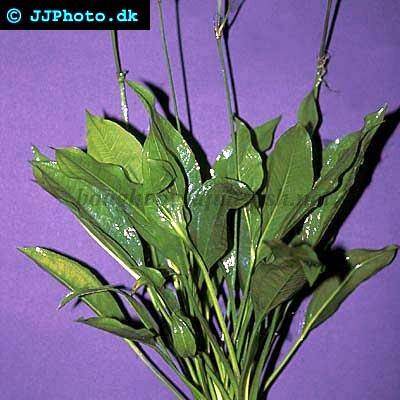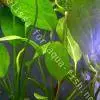Echinodorus bleheri
Scientific name: Echinodorus bleheri
Family: Alismataceae
Usual maximum size in aquariums: 20 - 50 cm (7.87 - 19.69 inch)
014
Recommended pH range for the species: 6.5 - 7.5
Recommended water hardness (dGH): 4 - 18°N (71.43 - 321.43ppm)
0°C 32°F30°C 86°F
Recommended temperature: 22 - 30 °C (71.6 - 86°F)
Reproduction of the plant: Rhizome
Origin (in the wild): South America
How fast these plants grow: Fast
Recommended substrate: Fine gravel
Demands on lighting: Medium
Ideal placement in a fish tank: Middle
Common Name
Amazon Sword Plant
Ideal Planting Area
Echinodorus bleheri is best suited for the middle ground of the aquarium. It can reach a height of 20 - 50 cm (7.87 - 19.69 inch), making it an excellent choice for adding depth and structure to the aquascape. In medium to large aquariums, it serves as a centerpiece plant, offering a lush green contrast to the surrounding flora. Its broad leaves provide shelter for fish and invertebrates, creating a more natural environment. Ensure the plant is placed in an area where its rapid growth will not overshadow other plants, particularly those requiring more light.
Propagation Methods
While Echinodorus bleheri is a rhizome plant, it can propagate in more than one way. One common method is through the development of adventitious plants around the mother plant. These small plantlets can be carefully pried free from the rosette of leaves and replanted into the substrate. Ensure they receive nutrients immediately to encourage strong root growth.
If grown emersed, the plant may produce flower stalks. With manual pollination using a soft brush, it’s possible to fertilize the flowers and produce seeds. However, this method is more complex and not commonly practiced by aquarists. For most enthusiasts, propagating via plantlets remains the most straightforward and effective approach.
Difficulty Level
Echinodorus bleheri is considered an easy plant to care for, making it an ideal choice for beginners. Its adaptability to a wide range of water conditions, including a pH range of 6.5 - 7.5 and water hardness of 4 - 18°N (71.43 - 321.43 ppm), contributes to its reputation as a hardy plant. Medium lighting is sufficient to keep this plant thriving, reducing the need for high-end lighting systems. Although it grows quickly, regular pruning can help maintain its shape and prevent it from overtaking the tank.
Short Description
Native to South America, the Amazon Sword Plant (Echinodorus bleheri) is a popular choice among aquarists due to its ease of care and vibrant green foliage. This species is similar to Echinodorus amazonicus but features slightly broader leaves that grow more upright. It can grow up to 50 cm (19.69 inches) in height, with a rosette of approximately 30 leaves varying in shades of green.
Though primarily used as an aquatic plant, Echinodorus bleheri can also grow in emersed conditions. Its roots act as the main nutrient source, so a nutrient-rich substrate is essential for optimal growth. The plant is capable of releasing oxygen into the water column, which can sometimes be observed as oxygen bubbles rising from its leaves. If the leaves turn yellow, this indicates an iron deficiency, and supplements should be added to the tank.
Medium lighting is ideal for this plant, which helps keep running costs low while ensuring healthy growth. Due to its rapid growth rate, regular pruning is necessary to prevent it from overshadowing other plants in the aquarium.

 Echinodorus “Ozelot”
Echinodorus “Ozelot” Echinodorus “Red Flame”
Echinodorus “Red Flame” Echinodorus “Red Special”
Echinodorus “Red Special” Echinodorus “Rubin”
Echinodorus “Rubin” Echinodorus “Tricolour”
Echinodorus “Tricolour” Echinodorus amazonicus
Echinodorus amazonicus Echinodorus angustifolius
Echinodorus angustifolius Echinodorus cordifolius
Echinodorus cordifolius Echinodorus grandiflorus
Echinodorus grandiflorus Echinodorus horemanii
Echinodorus horemanii Echinodorus latifolius
Echinodorus latifolius Echinodorus macrophyllus
Echinodorus macrophyllus Echinodorus major
Echinodorus major Echinodorus osiris
Echinodorus osiris Echinodorus parviflorus
Echinodorus parviflorus Echinodorus quadricostatus
Echinodorus quadricostatus Echinodorus schlueteri
Echinodorus schlueteri Echinodorus subalatus
Echinodorus subalatus Echinodorus tenellus
Echinodorus tenellus Echinodorus uruguayensis
Echinodorus uruguayensis Sagittaria graminea
Sagittaria graminea Sagittaria platyphylla
Sagittaria platyphylla Sagittaria subulata
Sagittaria subulata